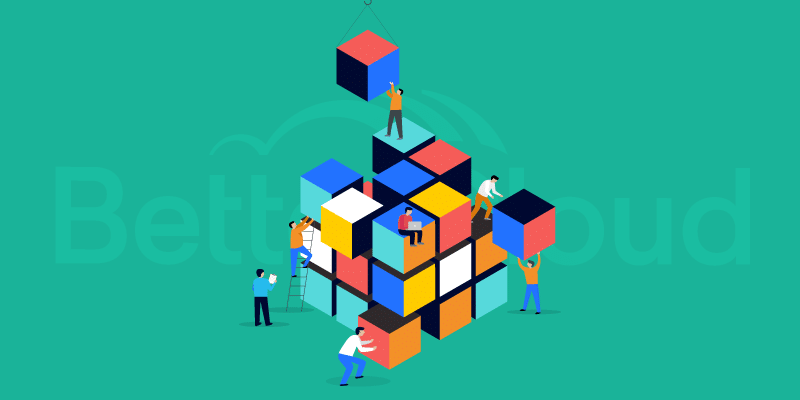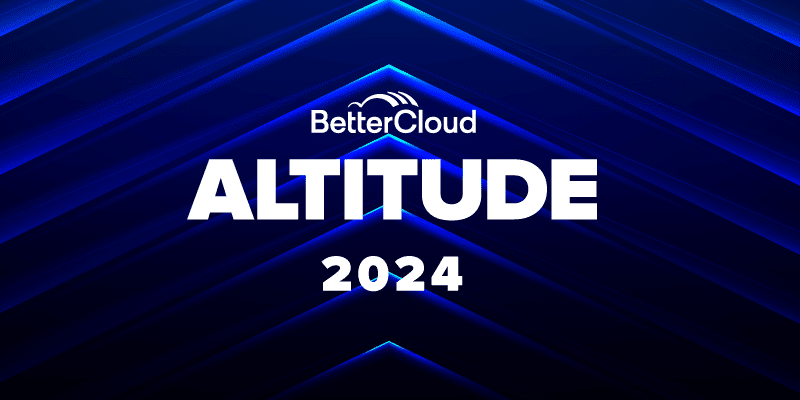Why You Need a SaaS Management Platform That Does It All
March 15, 2022
6 minute read
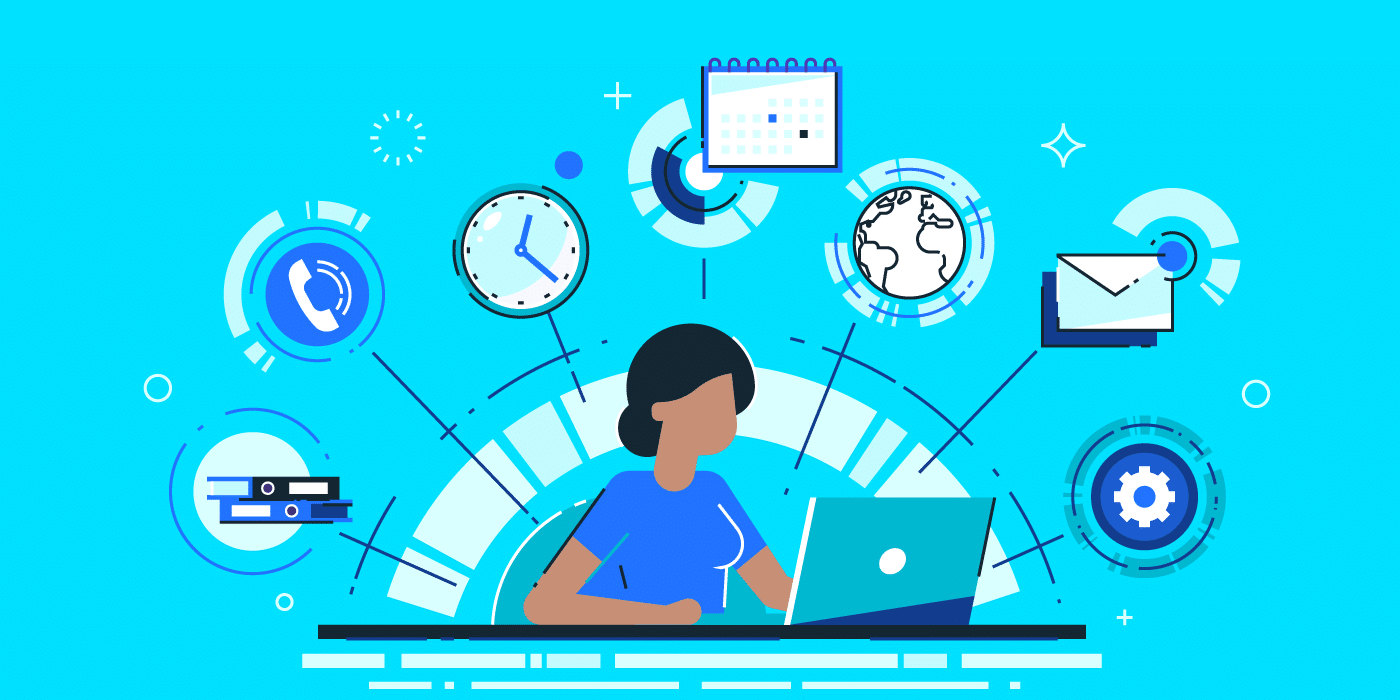
SaaS adoption was on the rise well before early 2020. Then, when the pandemic forced us all to work from home, SaaS use exploded.
With no time to research or compare tools, SaaS was adopted and deployed at breakneck speed. As each new challenge arose, IT scrambled to find a tool and implement it as fast as possible. For many IT teams, the SaaS whack-a-mole game lasted for far too long, as working remotely for “just a few weeks” became “the new normal.”
Managing and securing all of these new SaaS apps added a ton of work to IT’s already-full plate. The rapid pace of SaaS adoption left IT to deal with overloaded work days, 1000s of open browser tabs, never-ending ticket queues, and frustrated remote workers.
Now that the pandemic is becoming endemic, IT leaders are seeking to solve these challenges (and save their team’s sanity) by “right-sizing” their SaaS portfolio and getting control of the sprawl.
In fact, Gartner has identified management confluence as one of the “Top 6 Trends Impacting Infrastructure and Operations for 2022.” In this article, Gartner contributor Katie Costello discusses how the consolidation of multiple solutions into one comprehensive management tool can reduce costs and improve ROI.
Gartner even recommends a three-step process to achieve this: inventorying current tools in use, identifying potential areas where tools can be combined, and leveraging unified automation from a single dashboard.
An all-in-one SaaS management platform can easily do the work of multiple tools to become the workhorse of your IT department. With centralized SaaS visibility, automation, and security in one platform, an SMP’s value scales over time as you leverage and extend more of its capabilities.
However, if you don’t know what a fully featured SaaS management platform should truly be capable of, you can easily end up with a cobbled-together web of point solutions.
To learn what you need to know to make an optimal decision for your IT department, let’s walk through the following:
- What should an all-in-one SaaS management platform be able to do?
- How does an SMP compare to a SAM, CASB, IAM, IGA, or iPaaS?
- Why does your IT team need an all-in-one SaaS management platform?
- How can IT leaders leverage an SMP to drive value?
What should an all-in-one SaaS management platform be able to do?
To get started, let’s quickly review the Gartner definition of a SaaS management platform, and its core capabilities. In the 2021 edition of its Market Guide for SaaS Management Platforms (SMPs), Gartner defines SMPs as stand-alone tools that can discover, manage, and secure multiple SaaS applications from a central admin dashboard, delivered as a turnkey service.
The graphic below shows all of the functionality that a fully featured SMP like BetterCloud provides.
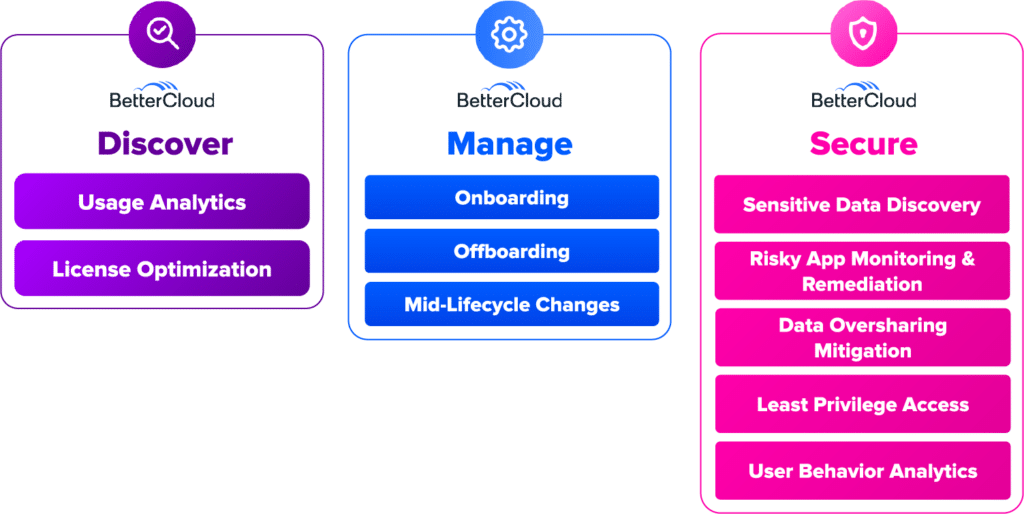
Discover: An SMP should serve as a single, centralized location that pulls in data from various sources to provide full visibility of your IT environment. It should be able to show you every app employees are logging into—even shadow IT. You should also be able to see the way each app is being accessed, such as OAuth or via SSO. The insights provided by an SMP should enable IT leaders to optimize their SaaS purchasing decisions.
Manage: From centrally managing all of your SaaS apps without having to log in to each separately, to implementing role-based controls, an SMP should be a “one-stop shop” for all of your SaaS management activities. To save time and reduce errors, an SMP should include powerful automation and orchestration capabilities. Any member of your IT team should be able to use an SMP’s no-code builder to orchestrate workflows that automate employee onboarding, offboarding, and internal job changes.
Secure: From insider threats to data loss prevention, an SMP should be able to secure your IT environment in multiple ways. Using the information it pulls in from connected apps, it can quickly locate sensitive or proprietary data, giving you valuable insight into which app it is located in and who owns the file. An SMP should also send you real-time security alerts, such as when files are shared with outsiders (such as competitors), and or when too many administrative-level accounts have been created. Security-related workflows created in the SMP should automatically remediate policy violations to enable your IT environment to “heal itself.”
The summaries above only just touch on the deep capabilities of a fully featured, all-in-one SaaS management platform. When evaluating whether or not an SMP is a good fit for your IT department, you should make sure the platform truly delivers everything Gartner says it should.
How does an SMP compare to a SAM, CASB, IAM, IGA, or iPaaS?
Every IT environment experiences the challenges of SaaS management in different ways. Security and compliance requirements can also greatly affect IT’s choice in what solutions they can and should use.
The graphic below shows where the functions of a SaaS management platform sit in relation to other platforms and the services they provide.
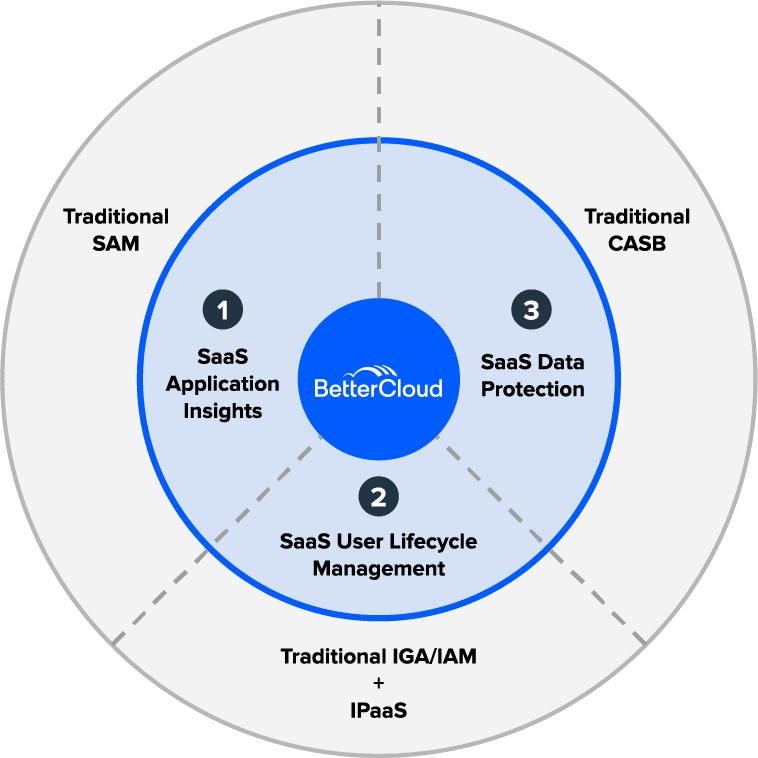
SMP vs. SAM: Similar to most SAMs, BetterCloud provides a centralized way to see all the apps in your environment, enabling you to optimize spend by right-sizing your license allocation. However, an SMP should provide far more than just a way to just track licenses. To go a step further and ensure licenses are always reclaimed quickly and accurately, an SMP can orchestrate complex workflows that automate account removal and creation. SMPs should also help secure your IT environment by allowing you to uncover risky apps and automatically revoke their access.
SMP vs. CASB: Most of BetterCloud’s mid-market and SMB customers do not need any additional platforms to create and enforce a robust set of IT security policies. Larger organizations, or those with very high compliance requirements, sometimes deploy a CASB alongside an SMP to create a single control point for SaaS application data flow.
SMP vs. IGA/IAM: Some BetterCloud customers leverage IGAs and IAMs to determine whether a new user can have access to an application based on company-specific policies. For most SMBs and mid-market companies, they are able to benefit from centralized and automated SaaS management without the need for one.
SMP vs. iPaaS: iPaaS platforms are often capable of automating some of the granular SaaS management tasks that an SMP can. However, because iPaaS don’t ingest and analyze data, orchestrating a lengthy automated onboarding or offboarding process leads to incredibly long, complex workflows that often require a developer to manage.
For a more in-depth look at where BetterCloud fits in this provider ecosystem, check out our article on how BetterCloud fits into your tech stack.
Why does your IT team need an all-in-one SaaS management platform?
Like we reviewed above, the marketplace for ways to solve many of the challenges of SaaS management is filled with providers and acronyms.
You may find yourself in an IT department that already has a point solution in place, thinking you may not need everything an SMP offers. You could also be attempting to compare products that all claim to be tools for “SaaS management,” and struggling to uncover their true differentiators.
A true all-in-one SMP like BetterCloud is purpose-built for IT’s specific needs and requirements, seeking to address their most urgent operational challenges.
Many of the point solutions in the market are built to deliver value for other business units or end users. For example, SAMs were created primarily for heads of finance and accounting. Most iPaaS are created to save developers time, not automate hardware procurement or user lifecycle management.
By leaving a fully featured SMP out of the mix, you will miss out on key opportunities for optimization. Worse, you could be leaving your company’s data vulnerable to misuse or theft.
Extremely detailed spend tracking can save money, but so does reclaiming licenses immediately after an employee departs. Quickly revoking access to all those apps and shared resources also protects sensitive data and makes it easier for your security team to pass compliance audits.
Simply optimizing spend will leave your IT environment vulnerable to well-meaning employees that log in to risky apps with their work credentials or share proprietary information with outsiders. Without the ability to easily orchestrate complex workflows, your IT team will keep spending far too much time as “ticket-takers.”
To keep your environment as secure and efficient as possible, it is important that your SMP have the power to address IT’s most pressing challenges.
How can IT leaders leverage an SMP to drive value?
When BetterCloud customers take full advantage of everything it has to offer, they can drive tremendous value in their company. Let’s walk through the benefits experienced by just one customer, a growing company with 1,200 employees that is saving over $1.12 million annually.
- After their IT team saw all their apps in one place, they gained important insights into what was and wasn’t being used. They are now saving $140,000 per year through license optimization.
- They used BetterCloud’s zero-touch automation capabilities to create a self-service SaaS access portal. As a result, they realized productivity gains of $796,000 annually as employees no longer had to wait for IT to manually grant app access.
- By automating their onboarding, offboarding, and mid-lifecycle change processes, they save $184,000 annually in IT staff time.
- Their operational efficiency improved so much that two full-time employees could refocus their responsibilities to support go-to-market efficiency and revenue growth.
- The company’s sensitive and proprietary data is now being protected with proactive monitoring and automated remediation policies on over 4,000,000 files.
- They identified and revoked OAuth access to 312 risky apps that did not meet security standards.
- To implement a least privilege access model, they reduced the number of users with super admin access from 15 to 3.
While every BetterCloud customer doesn’t always realize over $1 million in savings, the stats above highlight all the different ways a SMP can deliver value. From efficiency to security, a fully featured SMP is a single platform that provides multiple, far-reaching benefits for IT.
To get a sneak peek at what BetterCloud can discover about your IT environment, schedule a free, personalized SaaSOps assessment.



